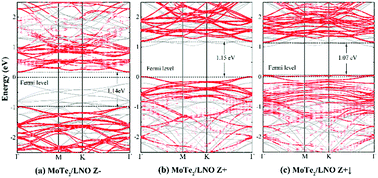Strong modulation of electronic properties of monolayer MoTe2 using a ferroelectric LiNbO3(0001) substrate†
Abstract
In this study, we used first-principles density functional theory (DFT) calculations to investigate the interface coupling mechanism of a MoTe2/LiNbO3(0001) heterostructure and the effect of the LiNbO3(0001) surface on the electronic properties of the MoTe2 overlayer. It was found that the interface coupling between monolayer MoTe2 and the LiNbO3(0001) surface is due to the so-called ionic–vdW interaction mechanism and that the interface charge transfer depends not only on the band alignment between the free-standing materials but also on the interface chemical environments. The interface charge transfer exhibits a strong dependence on the ferroelectric polarization direction. The MoTe2 overlayer on the thermodynamically preferred LiNbO3(0001) negative and positive surfaces is characterized by an electron depletion of 7.4 × 1012 and 3.32 × 1013 e cm−2, respectively, which results in a large band offset of 1.0 eV. This facilitates the fabrication of seamless homojunctions in monolayer MoTe2 on the oppositely polarized LiNbO3(0001) substrate. Furthermore, examination of the electronic properties of the ferroelectric–polarization–reversed MoTe2/LiNbO3(0001) hybrid system indicates a strong modulation of the transport properties of the MoTe2 overlayer, which provides a new possibility for the exploration of MoTe2-based ferroelectric field-effect transistors.



 Please wait while we load your content...
Please wait while we load your content...